2017 NISSAN ROGUE HYBRID engine
[x] Cancel search: enginePage 495 of 520
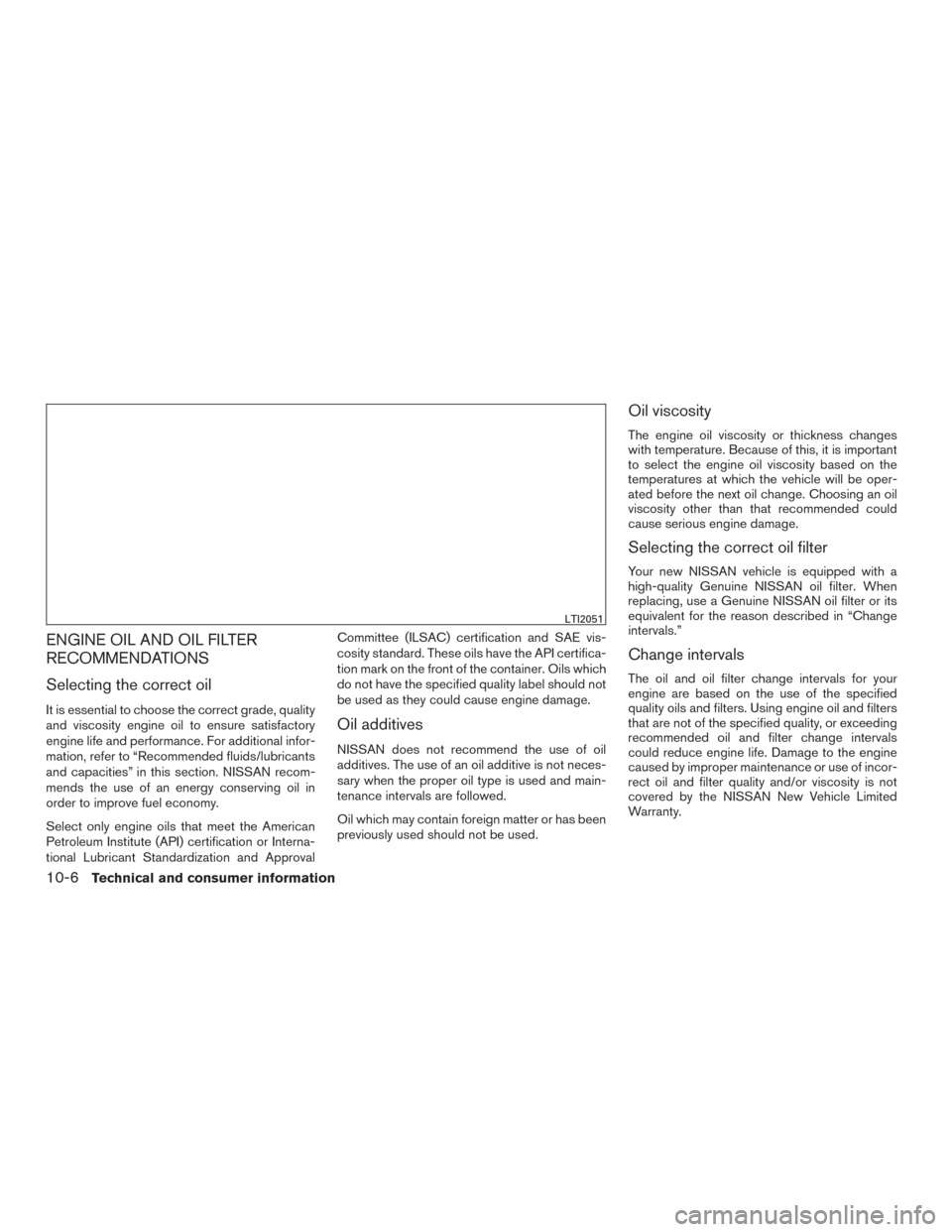
ENGINE OIL AND OIL FILTER
RECOMMENDATIONS
Selecting the correct oil
It is essential to choose the correct grade, quality
and viscosity engine oil to ensure satisfactory
engine life and performance. For additional infor-
mation, refer to “Recommended fluids/lubricants
and capacities” in this section. NISSAN recom-
mends the use of an energy conserving oil in
order to improve fuel economy.
Select only engine oils that meet the American
Petroleum Institute (API) certification or Interna-
tional Lubricant Standardization and ApprovalCommittee (ILSAC) certification and SAE vis-
cosity standard. These oils have the API certifica-
tion mark on the front of the container. Oils which
do not have the specified quality label should not
be used as they could cause engine damage.Oil additives
NISSAN does not recommend the use of oil
additives. The use of an oil additive is not neces-
sary when the proper oil type is used and main-
tenance intervals are followed.
Oil which may contain foreign matter or has been
previously used should not be used.
Oil viscosity
The engine oil viscosity or thickness changes
with temperature. Because of this, it is important
to select the engine oil viscosity based on the
temperatures at which the vehicle will be oper-
ated before the next oil change. Choosing an oil
viscosity other than that recommended could
cause serious engine damage.
Selecting the correct oil filter
Your new NISSAN vehicle is equipped with a
high-quality Genuine NISSAN oil filter. When
replacing, use a Genuine NISSAN oil filter or its
equivalent for the reason described in “Change
intervals.”
Change intervals
The oil and oil filter change intervals for your
engine are based on the use of the specified
quality oils and filters. Using engine oil and filters
that are not of the specified quality, or exceeding
recommended oil and filter change intervals
could reduce engine life. Damage to the engine
caused by improper maintenance or use of incor-
rect oil and filter quality and/or viscosity is not
covered by the NISSAN New Vehicle Limited
Warranty.
LTI2051
10-6Technical and consumer information
Page 496 of 520
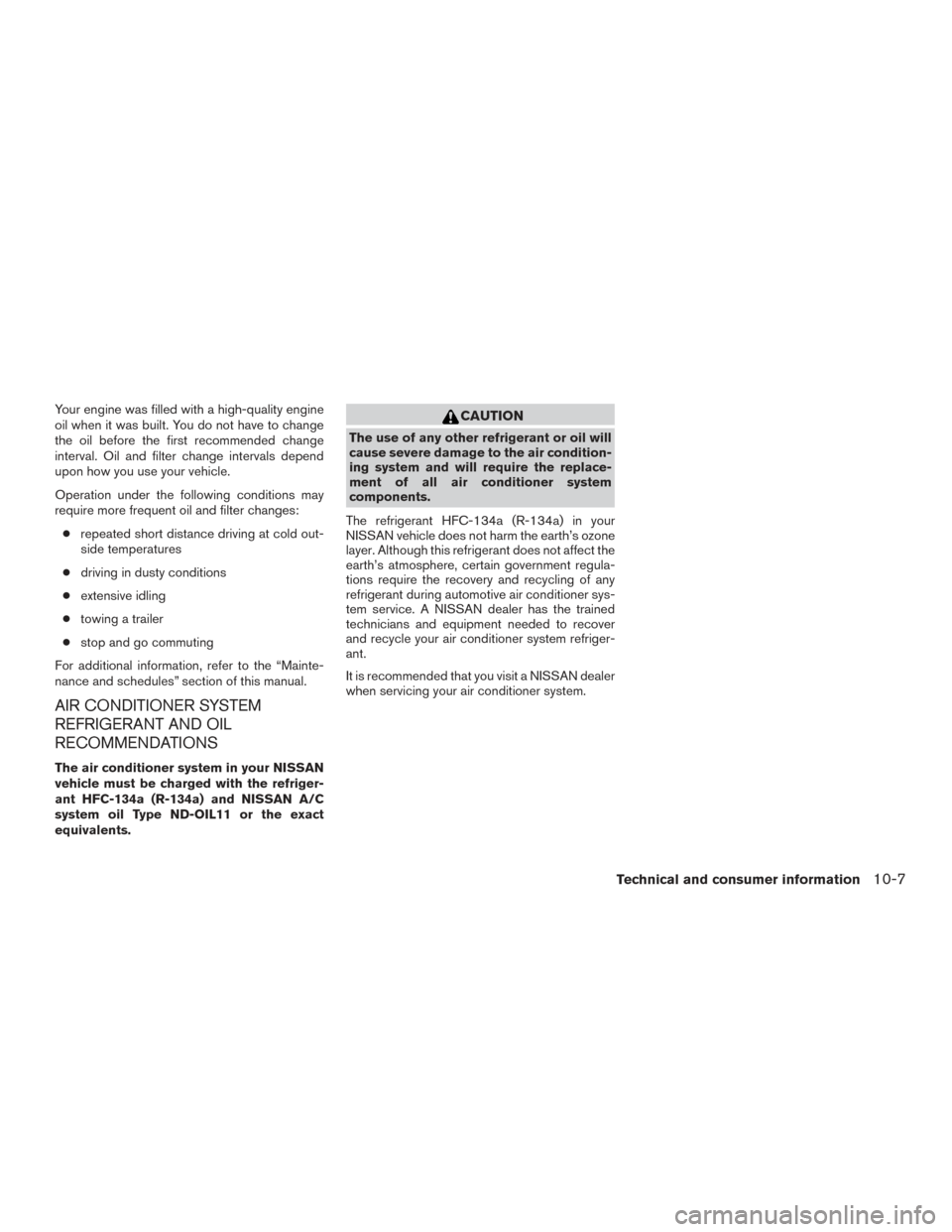
Your engine was filled with a high-quality engine
oil when it was built. You do not have to change
the oil before the first recommended change
interval. Oil and filter change intervals depend
upon how you use your vehicle.
Operation under the following conditions may
require more frequent oil and filter changes:● repeated short distance driving at cold out-
side temperatures
● driving in dusty conditions
● extensive idling
● towing a trailer
● stop and go commuting
For additional information, refer to the “Mainte-
nance and schedules” section of this manual.
AIR CONDITIONER SYSTEM
REFRIGERANT AND OIL
RECOMMENDATIONS
The air conditioner system in your NISSAN
vehicle must be charged with the refriger-
ant HFC-134a (R-134a) and NISSAN A/C
system oil Type ND-OIL11 or the exact
equivalents.
CAUTION
The use of any other refrigerant or oil will
cause severe damage to the air condition-
ing system and will require the replace-
ment of all air conditioner system
components.
The refrigerant HFC-134a (R-134a) in your
NISSAN vehicle does not harm the earth’s ozone
layer. Although this refrigerant does not affect the
earth’s atmosphere, certain government regula-
tions require the recovery and recycling of any
refrigerant during automotive air conditioner sys-
tem service. A NISSAN dealer has the trained
technicians and equipment needed to recover
and recycle your air conditioner system refriger-
ant.
It is recommended that you visit a NISSAN dealer
when servicing your air conditioner system.
Technical and consumer information10-7
Page 497 of 520
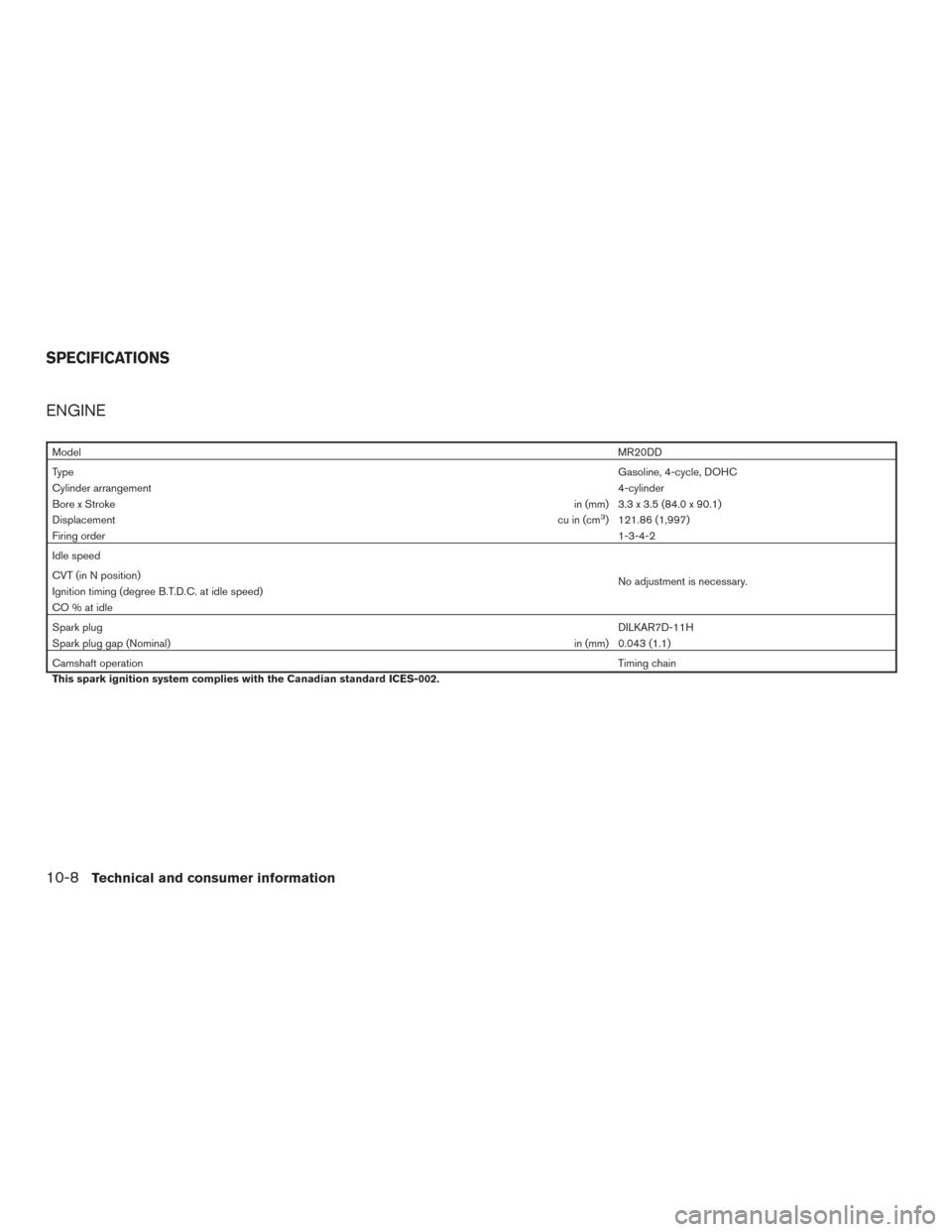
ENGINE
ModelMR20DD
Type Gasoline, 4-cycle, DOHC
Cylinder arrangement 4-cylinder
Bore x Stroke in (mm) 3.3 x 3.5 (84.0 x 90.1)
Displacement cu in (cm
3) 121.86 (1,997)
Firing order 1-3-4-2
Idle speed
No adjustment is necessary.
CVT (in N position)
Ignition timing (degree B.T.D.C. at idle speed)
CO%atidle
Spark plug
DILKAR7D-11H
Spark plug gap (Nominal) in (mm) 0.043 (1.1)
Camshaft operation Timing chain
This spark ignition system complies with the Canadian standard ICES-002.
SPECIFICATIONS
10-8Technical and consumer information
Page 499 of 520
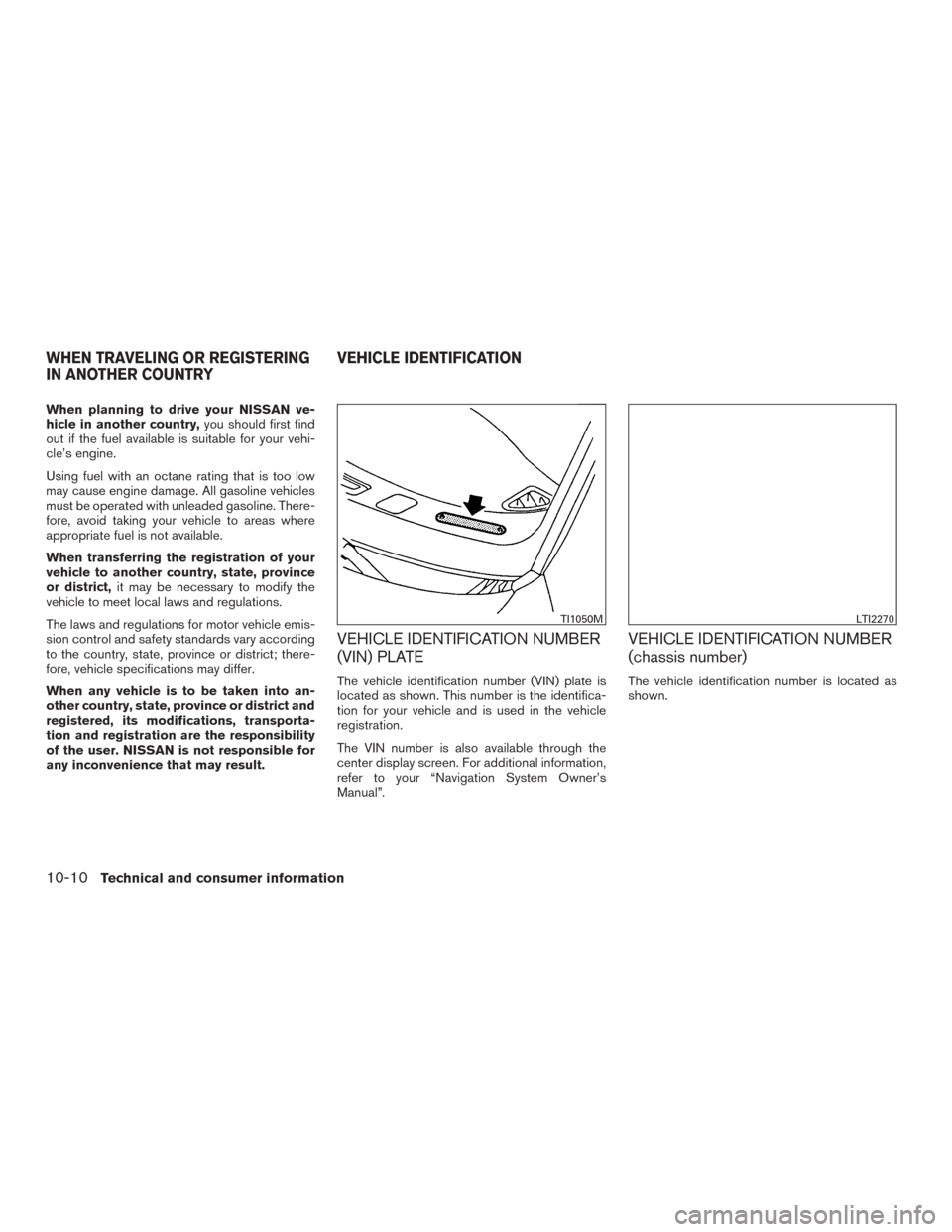
When planning to drive your NISSAN ve-
hicle in another country,you should first find
out if the fuel available is suitable for your vehi-
cle’s engine.
Using fuel with an octane rating that is too low
may cause engine damage. All gasoline vehicles
must be operated with unleaded gasoline. There-
fore, avoid taking your vehicle to areas where
appropriate fuel is not available.
When transferring the registration of your
vehicle to another country, state, province
or district, it may be necessary to modify the
vehicle to meet local laws and regulations.
The laws and regulations for motor vehicle emis-
sion control and safety standards vary according
to the country, state, province or district; there-
fore, vehicle specifications may differ.
When any vehicle is to be taken into an-
other country, state, province or district and
registered, its modifications, transporta-
tion and registration are the responsibility
of the user. NISSAN is not responsible for
any inconvenience that may result.
VEHICLE IDENTIFICATION NUMBER
(VIN) PLATE
The vehicle identification number (VIN) plate is
located as shown. This number is the identifica-
tion for your vehicle and is used in the vehicle
registration.
The VIN number is also available through the
center display screen. For additional information,
refer to your “Navigation System Owner’s
Manual”.
VEHICLE IDENTIFICATION NUMBER
(chassis number)
The vehicle identification number is located as
shown.
TI1050MLTI2270
WHEN TRAVELING OR REGISTERING
IN ANOTHER COUNTRY VEHICLE IDENTIFICATION
10-10Technical and consumer information
Page 500 of 520
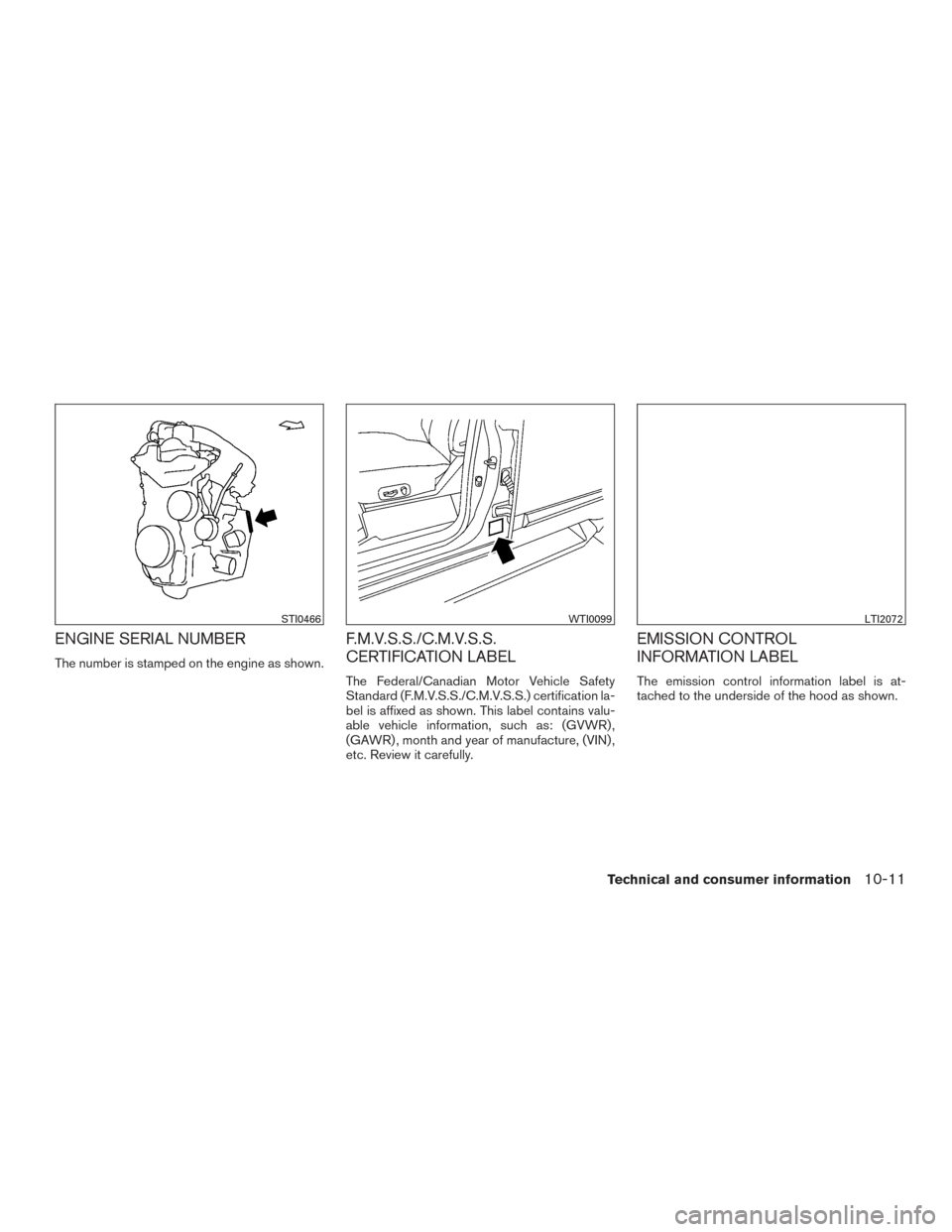
ENGINE SERIAL NUMBER
The number is stamped on the engine as shown.
F.M.V.S.S./C.M.V.S.S.
CERTIFICATION LABEL
The Federal/Canadian Motor Vehicle Safety
Standard (F.M.V.S.S./C.M.V.S.S.) certification la-
bel is affixed as shown. This label contains valu-
able vehicle information, such as: (GVWR) ,
(GAWR) , month and year of manufacture, (VIN) ,
etc. Review it carefully.
EMISSION CONTROL
INFORMATION LABEL
The emission control information label is at-
tached to the underside of the hood as shown.
STI0466WTI0099LTI2072
Technical and consumer information10-11
Page 509 of 520
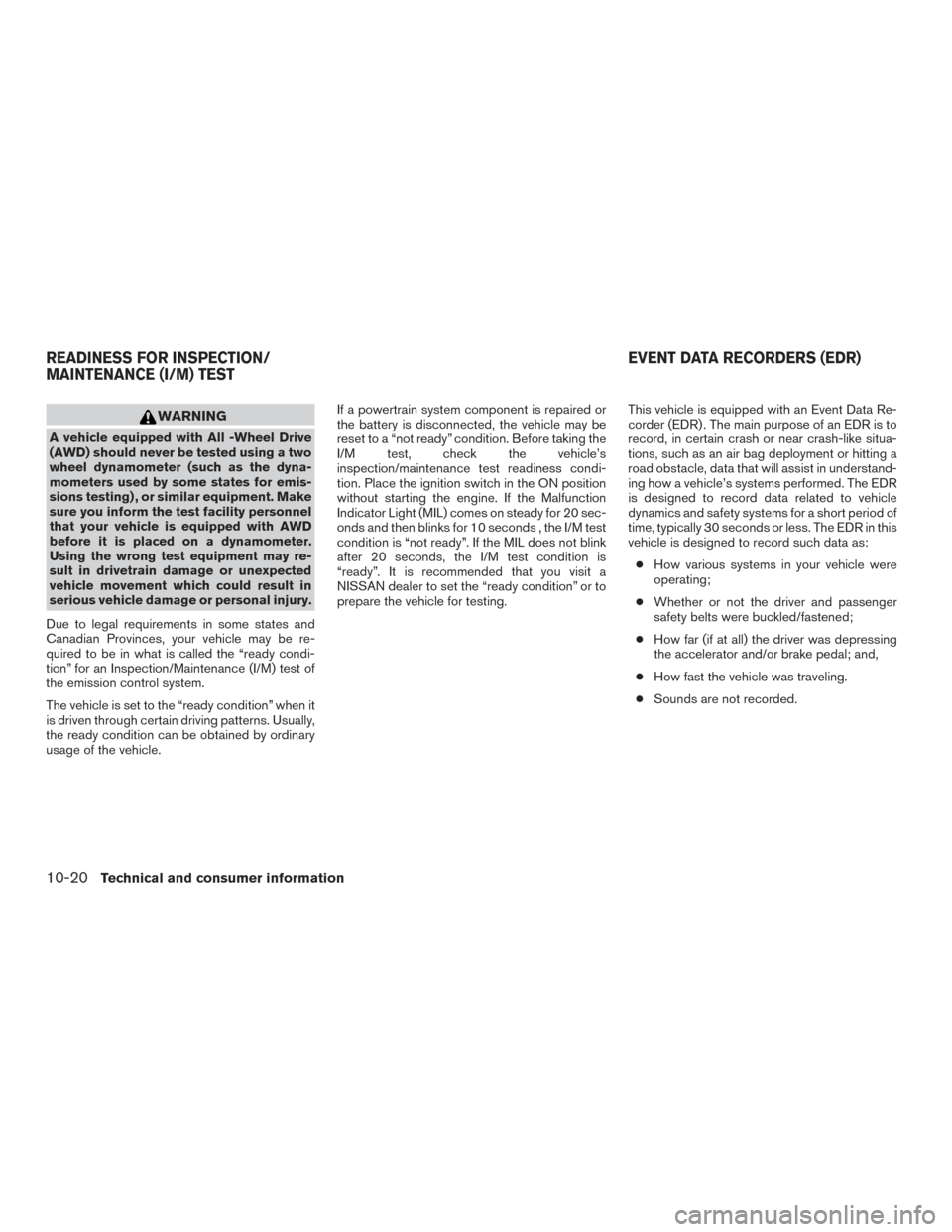
WARNING
A vehicle equipped with All -Wheel Drive
(AWD) should never be tested using a two
wheel dynamometer (such as the dyna-
mometers used by some states for emis-
sions testing) , or similar equipment. Make
sure you inform the test facility personnel
that your vehicle is equipped with AWD
before it is placed on a dynamometer.
Using the wrong test equipment may re-
sult in drivetrain damage or unexpected
vehicle movement which could result in
serious vehicle damage or personal injury.
Due to legal requirements in some states and
Canadian Provinces, your vehicle may be re-
quired to be in what is called the “ready condi-
tion” for an Inspection/Maintenance (I/M) test of
the emission control system.
The vehicle is set to the “ready condition” when it
is driven through certain driving patterns. Usually,
the ready condition can be obtained by ordinary
usage of the vehicle. If a powertrain system component is repaired or
the battery is disconnected, the vehicle may be
reset to a “not ready” condition. Before taking the
I/M test, check the vehicle’s
inspection/maintenance test readiness condi-
tion. Place the ignition switch in the ON position
without starting the engine. If the Malfunction
Indicator Light (MIL) comes on steady for 20 sec-
onds and then blinks for 10 seconds , the I/M test
condition is “not ready”. If the MIL does not blink
after 20 seconds, the I/M test condition is
“ready”. It is recommended that you visit a
NISSAN dealer to set the “ready condition” or to
prepare the vehicle for testing.
This vehicle is equipped with an Event Data Re-
corder (EDR) . The main purpose of an EDR is to
record, in certain crash or near crash-like situa-
tions, such as an air bag deployment or hitting a
road obstacle, data that will assist in understand-
ing how a vehicle’s systems performed. The EDR
is designed to record data related to vehicle
dynamics and safety systems for a short period of
time, typically 30 seconds or less. The EDR in this
vehicle is designed to record such data as:
● How various systems in your vehicle were
operating;
● Whether or not the driver and passenger
safety belts were buckled/fastened;
● How far (if at all) the driver was depressing
the accelerator and/or brake pedal; and,
● How fast the vehicle was traveling.
● Sounds are not recorded.
READINESS FOR INSPECTION/
MAINTENANCE (I/M) TEST EVENT DATA RECORDERS (EDR)
10-20Technical and consumer information
Page 512 of 520
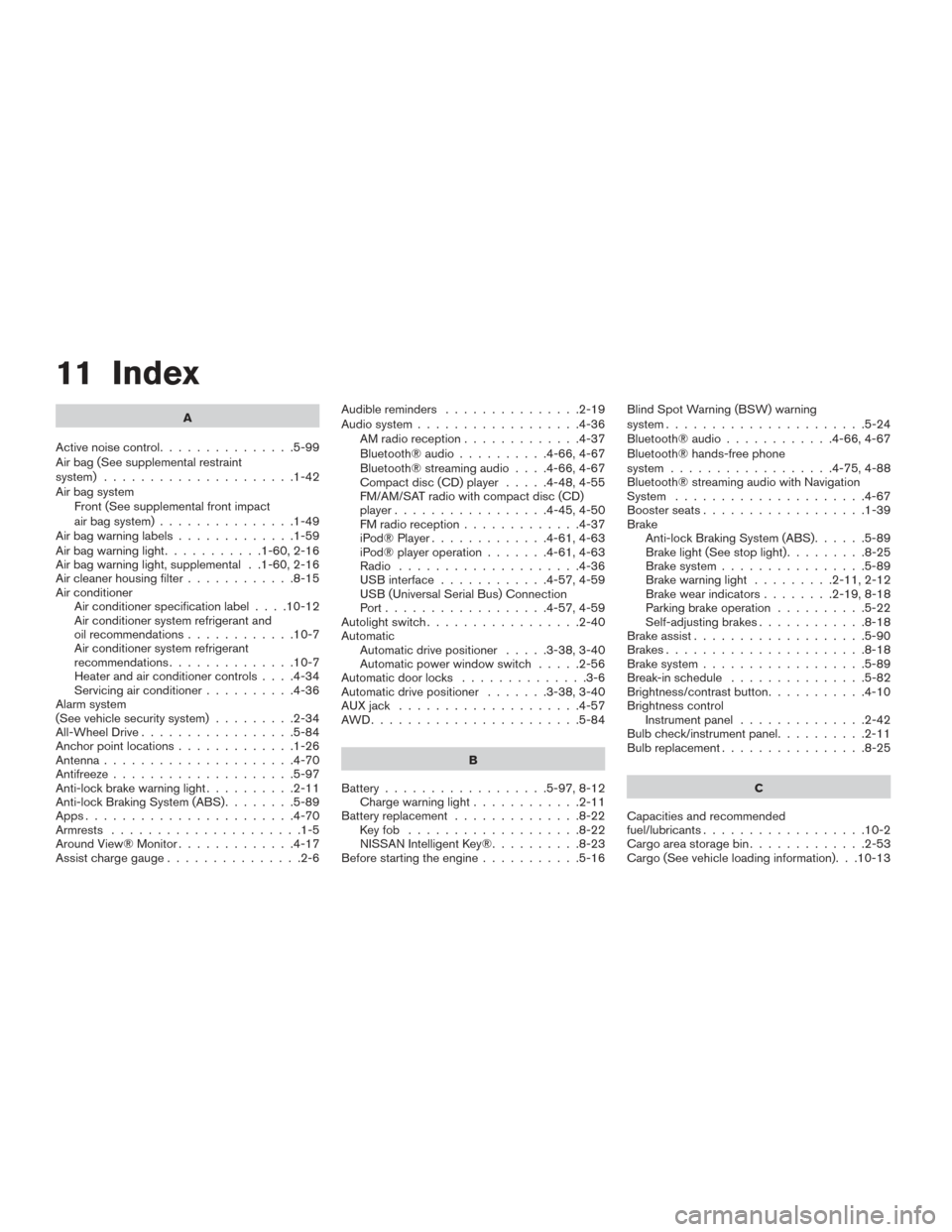
11 Index
A
Active noise control ...............5-99
Air bag (See supplemental restraint
system) .....................1-42
Air bag system Front (See supplemental front impact
air bag system) ...............1-49
Airbagwarninglabels.............1-59
Airbagwarninglight...........1-60,2-16
Air bag warning light, supplemental . .1-60, 2-16
Air cleaner housing filter ............8-15
Air conditioner Air conditioner specification label ....10-12
Air conditioner system refrigerant and
oil recommendations ............10-7
Air conditioner system refrigerant
recommendations ..............10-7
Heater and air conditioner controls ....4-34
Servicing air conditioner ..........4-36
Alarm system
(See vehicle security system) .........2-34
All-Wheel Drive .................5-84
Anchor point locations .............1-26
Antenna .....................4-70
Antifreeze ....................5-97
Anti-lock brake warning light ..........2-11
Anti-lock Braking System (ABS) ........5-89
Apps .......................4-70
Armrests .....................1-5
Around View® Monitor .............4-17
Assist charge gauge ...............2-6 Audible reminders
...............2-19
Audio system ..................4-36
AMradioreception.............4-37
Bluetooth®audio..........4-66,4-67
Bluetooth® streaming audio ....4-66,4-67
Compact disc (CD) player .....4-48,4-55
FM/AM/SAT radio with compact disc (CD)
player.................4-45,4-50
FMradioreception.............4-37
iPod® Player .............4-61,4-63
iPod® player operation .......4-61,4-63
Radio ....................4-36
USB interface ............4-57,4-59
USB (Universal Serial Bus) Connection
Port..................4-57,4-59
Autolight switch .................2-40
Automatic Automatic drive positioner .....3-38,3-40
Automatic power window switch .....2-56
Automatic door locks ..............3-6
Automatic drive positioner .......3-38,3-40
AUXjack ....................4-57
AWD.......................5-84
B
Battery ..................5-97,8-12
Chargewarninglight............2-11
Battery replacement ..............8-22
Keyfob ...................8-22
NISSAN Intelligent Key® ..........8-23
Before starting the engine ...........5-16 Blind Spot Warning (BSW) warning
system......................5-24
Bluetooth® audio
............4-66,4-67
Bluetooth® hands-free phone
system..................4-75,4-88
Bluetooth® streaming audio with Navigation
System .....................4-67
Boosterseats..................1-39
Brake Anti-lock Braking System (ABS) ......5-89
Brakelight(Seestoplight).........8-25
Brake system ................5-89
Brakewarninglight .........2-11,2-12
Brakewearindicators........2-19,8-18
Parking brake operation ..........5-22
Self-adjusting brakes ............8-18
Brake assist ...................5-90
Brakes ......................8-18
Brake system ..................5-89
Break-inschedule ...............5-82
Brightness/contrast button ...........4-10
Brightness control Instrument panel ..............
2
-42
Bulb check/instrument panel ..........2-11
Bulbreplacement................8-25
C
Capacities and recommended
fuel/lubricants ..................10-2
Cargoareastoragebin.............2-53
Cargo (See vehicle loading information). . .10-13
Page 513 of 520
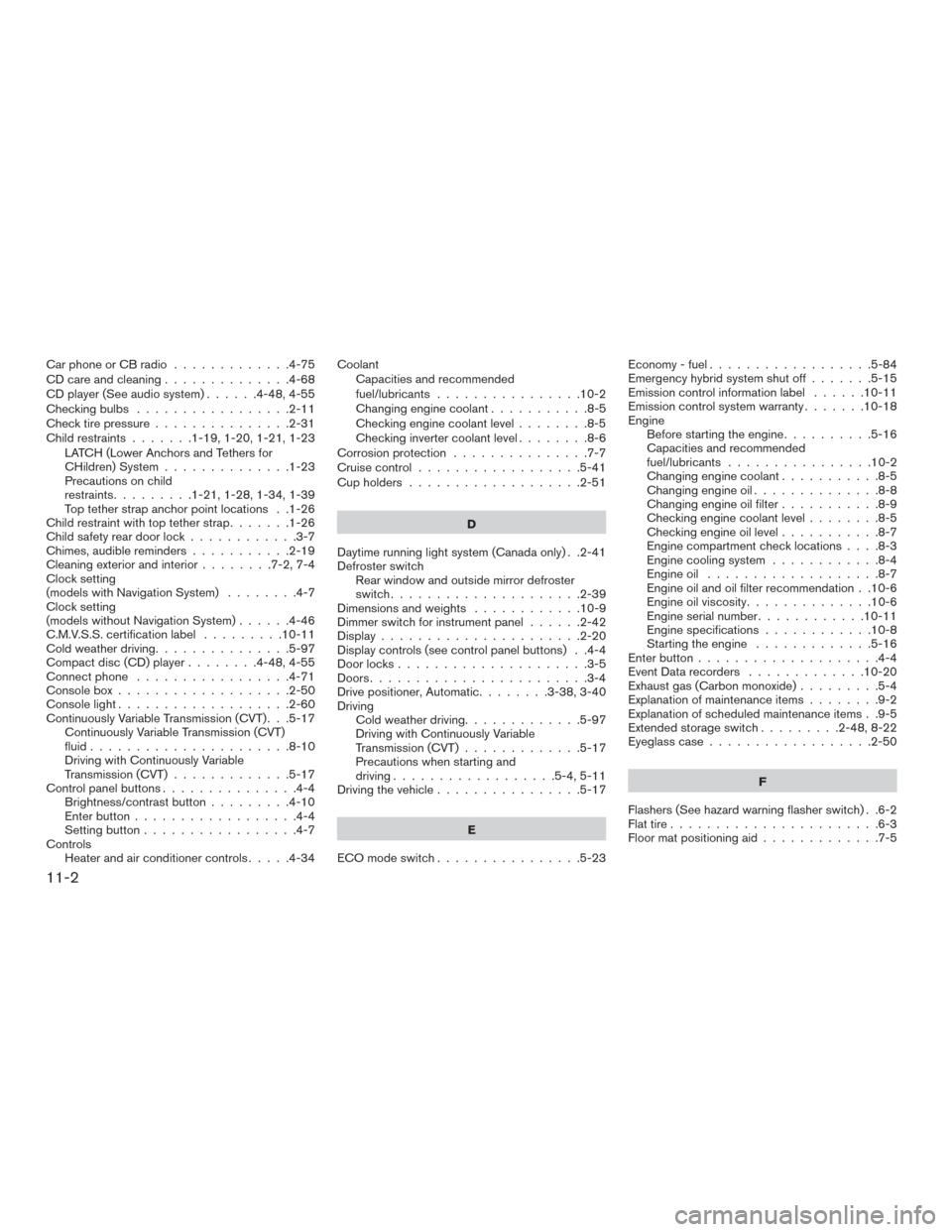
Car phone or CB radio.............4-75
CD care and cleaning ..............4-68
CD player (See audio system) ......4-48,4-55
Checkingbulbs .................2-11
Check tire pressure ...............2-31
Child restraints .......1-19,1-20,1-21,1-23
LATCH (Lower Anchors and Tethers for
CHildren) System ..............1-23
Precautions on child
restraints.........1-21,1-28,1-34,1-39
Top tether strap anchor point locations . .1-26
Child restraint with top tether strap .......1-26
Child safety rear door lock ............3-7
Chimes, audible reminders ...........2-19
Cleaningexteriorandinterior........7-2,7-4
Clock setting
(models with Navigation System) ........4-7
Clock setting
(models without Navigation System) ......4-46
C.M.V.S.S. certification label .........10-11
Cold weather driving ...............5-97
Compact disc (CD) player ........4-48,4-55
Connect phone .................4-71
Consolebox...................2-50
Consolelight...................2-60
Continuously Variable Transmission (CVT) . . .5-17 Continuously Variable Transmission (CVT)
fluid ......................8-10
Driving with Continuously Variable
Transmission (CVT) .............5-17
Control panel buttons ...............4-4
Brightness/contrast button .........4-10
Enterbutton..................4-4
Setting button .................4-7
Controls Heater and air conditioner controls .....4-34Coolant
Capacities and recommended
fuel/lubricants ................10-2
Changingenginecoolant...........8-5
Checking engine coolant level ........8-5
Checking inverter coolant level ........8-6
Corrosion protection ...............7-7
Cruisecontrol..................5-41
Cupholders...................2-51
D
Daytime running light system (Canada only) . .2-41
Defroster switch Rear window and outside mirror defroster
switch.....................2-39
Dimensionsandweights ............10-9
Dimmer switch for instrument panel ......2-42
Display......................2-20
Display controls (see control panel buttons) . .4-4
Door locks .....................3-5
Doors ........................3-4
Drive positioner, Automatic ........3-38,3-40
Driving Cold weather driving .............5-97
Driving with Continuously Variable
Transmission (CVT) .............5-17
Precautions when starting and
driving ..................5-4,5-11
Driving the vehicle ................5-17
E
ECO mode switch ................5-23 Economy-fuel..................5-84
Emergency hybrid system shut off
.......5-15
Emission control information label ......10-11
Emission control system warranty .......10-18
Engine Before starting the engine ..........5-16
Capacities and recommended
fuel/lubricants ................10-2
Changing engine coolant ...........8-5
Changingengineoil..............8-8
Changing engine oil filter ...........8-9
Checking engine coolant level ........8-5
Checking engine oil level ...........8-7
Engine compartment check locations ....8-3
Engine cooling system ............
8
-4
Engineoil ...................8-7
Engine oil and oil filter recommendation . .10-6
Engine oil viscosity ..............10-6
Engine serial number ............10-11
Engine specifications ............10-8
Starting the engine .............5-16
Enter button ....................4-4
Event Data recorders .............10-20
Exhaust gas (Carbon monoxide) .........5-4
Explanation of maintenance items ........9-2
Explanation of scheduled maintenance items . .9-5
Extended storage switch .........2-48,8-22
Eyeglass case ..................2-50
F
Flashers (See hazard warning flasher switch) . .6-2
Flat tire .......................6-3
Floor mat positioning aid .............7-5
11-2